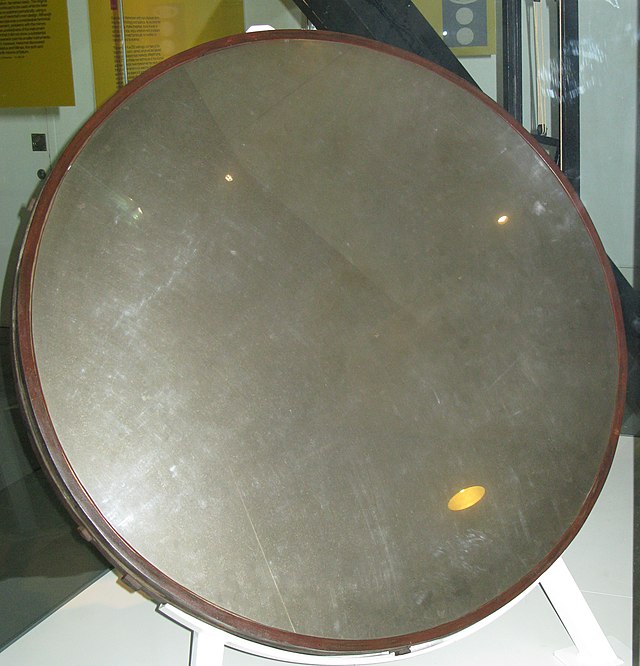Top Qs
Timeline
Chat
Perspective
List of largest optical telescopes in the British Isles
From Wikipedia, the free encyclopedia
Remove ads
List of largest optical telescopes in Ireland and the United Kingdom is a list of the largest optical telescopes in the British Isles, including in the United Kingdom and Ireland.






The most famous telescopes include Herschel's reflector, with which he discovered Georgium Sidus (the planet Uranus), and the Leviathan of Parsonstown which at 72 inches (1.83 metres) was for decades the largest aperture telescope in the world. In the 20th century many older telescopes are popular tourist attractions, such as at the Royal Observatory in Greenwich, London. There are also a number of modest instruments at universities used for various astronomical projects or education.
The largest optical telescope in Britain was the Isaac Newton Telescope, which had a 98-inch (2.5 m) mirror; it was located at the Royal Greenwich Observatory, Herstmonceux from 1965 to 1980, but was then relocated to Roque de los Muchachos Observatory on La Palma, Canary Islands.
The list is not representative of the largest telescopes operated by the United Kingdom or Ireland, which by the 20th century were building large telescopes overseas or in the southern hemisphere for better weather or other reasons.
Remove ads
Current list
Summarize
Perspective
The following is a non-comprehensive list of optical telescopes currently located in the British Isles with an aperture of 24 inches (61 cm) or greater:
Remove ads
Historical
- Isaac Newton Telescope at Herstmonceux, 98 in (249 cm) (1965–1979)
- Leviathan of Parsonstown, 1842–c. 1890
- 3-foot telescope at Parsons
- RGO telescopes at different points in its history[20]
- 38-inch Hargreaves Reflector (1960)
- Yapp 36-inch Reflector (1932)
- 30-inch Steavenson Reflector (1939)
- 28-inch Refractor (1893)
- Thompson Telescope with a 26-inch refractor and 30-inch reflector on one mounting (1896)
- Lassell 2-foot Reflector (1845)
- Isaac Roberts 20-inch reflector (1885)
- Western Equatorial (c. 1824)
- 13-inch Astrographic Refractor (1890)
- Merz 12.8-inch Visual Refractor (1859–1893) (this was replaced by the 28-inch Grubb in the onion dome)
- Thomson 9-inch Photographic Refractor (c. 1888)
- Sheepshanks refractor 6.7-inch (1838) (aka Sheepshanks Equatorial)
- 6-inch Franklin Adams Camera (1898)
- Shuckburgh telescope a 4.1-inch aperture Refractor (1791)
- At the Observatory Science Center (at Herstmonceux)[21]
- Hargreaves 38-inch Congo Schmidt
- Yapp 36-inch reflector
- Thompson 30-inch reflector
- Thompson 26-inch reflector
- Markree Observatory 13.3" Cauchoix (the largest refractor of the early 1830s)
- A.A. Commons reflectors (later reworked into Crossley and Harvard telescopes)
- Lassel's reflector, this 24-inch metal mirror telescope was used to discover the moons Triton and Hyperion.[22]
- Newton's reflector
- 40-foot telescope (England)
- Armagh Observatory 15-inch Grubb reflecting telescope.[23] Specula metal mirror mounted on an equatorial, with clockwork-drive.[23]
- Bedford Observatory Tully 5.9-inch refractor (8.5 feet focal length); Dollond mount with Sheepshanks clockwork drive.[24]
- Cambridge Observatory 36-inch (3 feet = 91.44 cm) aperture reflector
Remove ads
Observations
A noted accomplishment of the biggest telescope at the time, Ross's "six foot" leviathan, was the observation of the spiral structure of M51, which was presented at Cambridge in the summer of 1845.[25] Herschel was also quite prolific discovering a planet and many moons of the Solar system with his reflectors.
See also
- Lists of telescopes
- List of telescopes of Australia
- David Dunlap Observatory (Largest telescope of the British Empire in the 1930s)
References
External links
Wikiwand - on
Seamless Wikipedia browsing. On steroids.
Remove ads
